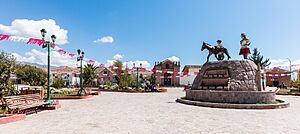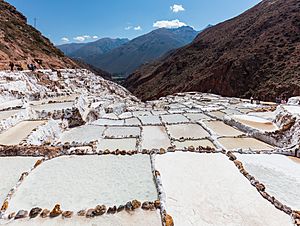Maras, Peru facts for kids
Quick facts for kids
Maras
San Francisco de Maras
|
|
|---|---|
|
Town
|
|

View of the Main Square of Maras.
|
|
| Country | Peru |
| Region | Cusco |
| Province | Urubamba |
| District | Maras |
| Elevation | 3,300 m (10,800 ft) |
| Population
(2005)
|
|
| • Total | 1,730 |
| Demonym(s) | Mareño, -ña |
| Time zone | UTC-5 (PET) |
Maras is a small town in Peru. It's located in the famous Sacred Valley of the Incas. This valley is about 40 kilometers (25 miles) north of the city of Cusco. Maras is very famous for its amazing salt ponds. People have been collecting salt here since the time of the ancient Inca Empire!
The salt ponds are about four kilometers (2.5 miles) north of the town. They are found in a canyon that goes down to the Vilcanota River. This river is also known as the upper Urubamba River. There are more than 5,000 salt ponds in Maras. Some of these ponds are owned by families, while others are not currently used.
Contents
Exploring Maras: Location and Features
The Maras area is easy to reach by a paved road. This road connects to the main route through the Sacred Valley. This main road runs between the city of Cusco and other nearby towns.
When you visit Maras, there are several interesting places to see:
- The old colonial church.
- The nearby Moray Inca ruins, which are ancient Inca sites.
- The special local salt evaporation ponds.
- The beautiful scenery all around the town.
How Salt is Made: The Maras Salt Ponds
People have been getting salt in Maras for a very long time. They have done this since before the Inca Empire existed! They get salt by letting salty water from an underground stream dry up. This very salty water comes out of a natural spring.
The water flows into a complex system of small channels. These channels are built so the water slowly moves down to hundreds of old terraced ponds. Most of these ponds are less than four meters (13 feet) square. None of them are deeper than thirty centimeters (12 inches).
All the ponds are shaped like polygons. Workers carefully control the water flow. The ponds are built at slightly different heights. This allows the water to flow through many small branches of the water supply channels. The water enters each pond slowly through a small opening in its side wall.
Keeping the channels, walls, and ponds in good shape needs teamwork. The people who work the ponds cooperate closely. Local residents and workers agree that this cooperative system started during the Inca times, or maybe even earlier.
The Salt Harvesting Process
As the sun warms the ponds, the water slowly evaporates. The water becomes super salty, and salt crystals begin to form. These crystals stick to the inner surfaces of the pond's earthen walls and floor.
Once enough salt has formed, the pond's keeper closes the water opening. They let the pond dry out completely. Within a few days, all the water has evaporated, and only salt remains. This process is repeated for about a month, building up more salt over time.
When there is enough salt, the keeper carefully scrapes it off. They collect the dry salt from the sides and bottom of the pond in layers.
- The first layer is usually pink or white. This is the highest quality salt, used for cooking.
- The second layer is called bulk salt. It is not as high quality as the first layer and is usually white.
- The third layer is typically brown. This type of salt is used for industrial purposes.
Some of this salt is sold at a gift shop nearby.
Who Can Harvest Salt?
Traditionally, anyone who wanted to harvest salt could use the salt mines. However, the owners of the salt ponds must be members of the local community. If new families join the community and want to manage a salt pond, they get one that is farthest from the main community.
The size of the salt pond given to a family depends on how many people are in that family. Usually, there are many unused salt pools available for farming. Anyone who wants to become a salt farmer just needs to find an empty pond that isn't being used. They then talk to the local cooperative group. They learn how to properly care for a pond within the community's system, and then they can start working.
However, in September 2019, the company that owns the salt pans, MaraSal S.A., made an announcement. They said that tourists are no longer allowed to walk directly on the salt ponds. This rule was put in place to prevent contamination of the salt.
Famous People from Maras
- Antonio Sinchi Roca Inka: He was a Quechua painter from the 17th century.
See also
 In Spanish: Maras (Urubamba) para niños
In Spanish: Maras (Urubamba) para niños




